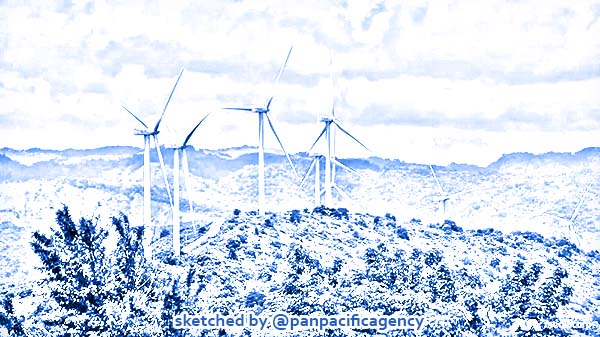Global Wind Energy Council partners with Vietnam, Thailand, Singapore to accelerate wind energy in SE Asia

The Sidrap wind farm. (Photo: Jack Board). Sketched by the Pan Pacific Agency.
HANOI, Oct 31, 2019, Hanoi Times. Three memorandums of understanding (MOUs) signed with Vietnam’s Binh Thuan Wind Energy Association (BWEA), Thai Wind Energy Association (ThaiWEA), and Sustainable Energy Association of Singapore (SEAS) are expected to accelerate the growth of wind energy in South East Asia, with a focus on Vietnam and Thailand, reported the Hanoi Times.
The partnership aims to strengthen the deployment of wind energy by engaging all relevant stakeholders in a key region for economic growth, where the energy generation mix remains reliant on fossil fuels despite tremendous renewable energy potential, GWEC said in a press release.
Vietnam and Thailand are well positioned to lead the energy transition in South East Asia, with 1GW and 800MW of onshore wind expected to be installed over the next 5 years, respectively, if challenges such as power purchase agreement (PPA) bankability, permitting and local capacity for financing are overcome, according to GWEC Market Intelligence.
The MOUs were signed on October 31 at the Asia Clean Energy Summit during Singapore International Energy Week in attendance of Salvatore Vinci, Deputy Director of Country Support and Partnership, International Renewable Energy Agency (IRENA).
The deals (i) recognizes the mutual interests of each organization in upscaling wind energy and promoting its role in sustainable development; (ii) facilitates cooperation in the field of wind energy development, with a view to establishing positive policy environments and an acceleration pathway for wind power in the region, and particularly Vietnam and Thailand; (iii) and support the development of technical activities, joint publications and other initiatives.
Liming Qiao, Asia Director of GWEC, said: “South East Asia will become a key growth region for renewable energy. Steady GDP growth, urbanization and rising populations have fueled the region’s electricity demand, which has increased by an average 6.1% annually since 2000. However, fossil fuels, and particularly coal-fired generation, continue to dominate the energy generation mix, with adverse socioeconomic and health impacts.
It is imperative that stakeholders across South East Asia – from governments to investors to communities – work together to advance the deployment of clean energy. We are confident that through the new cooperation with our regional partners, we can overcome challenges such as system integration and market design, in order to promote the role of wind energy in South East Asia’s sustainable development.”
Bui Van Thinh, Chairman of BWEA, said: “BWEA has been working closely with GWEC in the past two years attempting to set up a Vietnam National Wind Energy Association. With Vietnam wind development storming ahead of the ASEAN pack, the time is no better than now, to have an industry association to represent the wind industry in Vietnam. We look forward to a more comprehensive collaboration with GWEC and other regional associations to build a robust regional partnership.”
Linh Pham